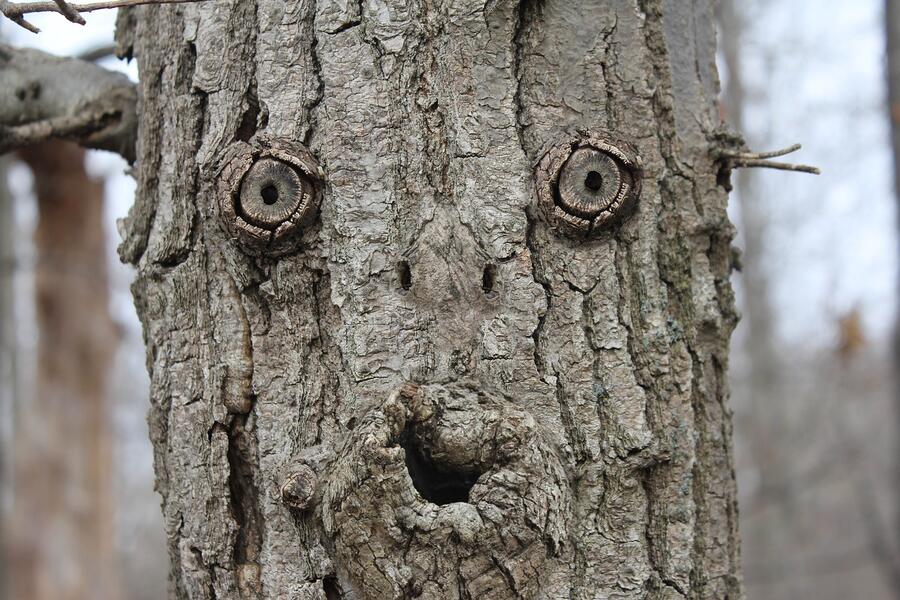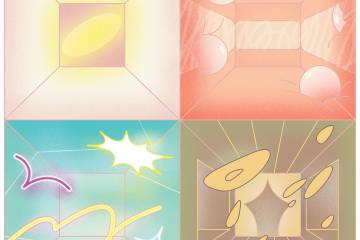During a friend's watch party for the 2024 Summer Olympics, my gaze diverted momentarily from the sports spectacle to the wood console the TV stood on. I wasn't admiring the handiwork; rather I noticed the drawer pulls that resembled a pair of eyes, and the wide crescent opening in the large straw basket centered beneath that functioned as smiling mouth. I grinned and mentioned my discovery to the homeowner who sat to my right.
"Oh, my God, yes! How did I never see that?" she said, also now smiling. "Now I can't unsee it."
As humans, we're hardwired to discern such recognizable and often meaningful patterns, a psychological phenomenon referred to as pareidolia (pronounced par-i-DOH-lee-a). We see the face of an old man in the knots of a tree, the shape of an animal in the clouds, the man on the moon. Stemming from the Greek words para, meaning "beside," and eidolon, meaning "image" or "form," pareidolia is often associated with finding or assigning human physical characteristics in nature. But it also includes the perception of any object in any medium, like the facade of a building or rear of a car. It can even include hearing distinct sounds that only appear to be there, like voices or music in flowing water—often referred to as auditory pareidolia.
What might appear as simple amusement had clear benefits to our ancestors, according to evolutionary psychologists. Seeing patterns in thousands of random stimuli likely served as survival mechanism, enabling people to quickly identify faces and threats in the natural world—Is that a bear off in the distance?
Today, scientists at Johns Hopkins are working to expand the understanding and applications of the phenomenon, including its use in injury and illness rehabilitation, creativity enrichment, mental well-being, and as diagnostic tool for conditions such as dementia with Lewy bodies. (Visual hallucinations are a hallmark feature of DLB, so JHU faculty want to use a pareidolia test as a marker for the condition.)
The sudden surge in activity at Hopkins has a single catalyst: Pat Bernstein. In 2014, Bernstein had brain surgery at Johns Hopkins Hospital to remove a benign meningioma tumor. Months of difficult recovery followed, and during that period while hiking a wooded trail near her home—one she had walked hundreds of times—she noticed for the first time a tree at the trailhead whose branches appeared to be two outstretched arms. A nearby tree's roots formed a long snake that pointed toward the trail ahead. "It's like the trail was welcoming me back; it was such an emotional experience," she says. "Since then, I began to recognize alternative images that nature creates on trees, rocks, and mud piles and photographed them. That became my passion for the next nine years." Her experience sparked an interest in the broader therapeutic potential, a new direction that resulted in her funding interdisciplinary research at Johns Hopkins.
Susan Magsamen, executive director of the International Arts + Mind Lab at the Pedersen Brain Science Institute, says that though neuroscientists have known about pareidolia for some time (the concept dates back to 1866, but it wasn't named until 1962), it remains a little-understood and underresearched neurological phenomenon.
"We think pareidolia may enhance focus, mood, creativity, imagination, and agility in problem-solving because you're seeing things in a different way," Magsamen says. "We're early days in this work, but it's fascinating and there's so much potential for these glimmers of perception."
Last year, Magsamen's team conducted a study to measure hallucination proneness across populations. Using a "signal detection pareidolia test" developed by Hopkins researchers, the study found that people more prone to hallucinations tend to see faces more often and tend to expect to see faces after seeing one before. The work served as further evidence that some are better than others at discerning patterns, indicating there's a pareidolic scale. "One thing we want to find out is if we can enhance or teach this ability, to get people to start to look for patterns and what impact that might have on creativity in general," she says.
Cognitive scientists at Homewood like Ed Connor, meanwhile, are conducting neurobiological research into pareidolia to understand the brain mechanisms behind it.
"I think the brain is so carefully wired to process face information that it's evoked into play as soon as anything even vaguely face shape is present," says Connor, director of the Krieger Mind/Brain Institute. The Connor Lab has begun experiments, using macaque monkeys (the closest model to human cognition we have) to measure how neural activity in the brain changes at that moment of pareidolic transition.
"To study that, neuroscientists look for situations that are right on the cusp between seeing something and not really being consciously aware of it," he continues. "What is the extra add-on in the brain that produces that 'aha moment' of seeing the face in there? And then coincidentally, what changes in all that processing such that you will always see that again immediately. Something happens in your visual memory. Like your friend said, 'I will never be able to unsee that.'"
Anna Agranovich and Stephen Wegener, rehabilitation psychologists at the School of Medicine, see potential for pareidolia in improving quality of life for those recovering from physical injury or illness. Wegener, a professor in the Department of Physical Medicine and Rehabilitation, says following a major injury or illness, some individuals experience significant decline in well-being and mood. However, studies have documented that some individuals experience post-traumatic growth that can lead to new ways of thinking, living, and relating to the world. Wegener and Agranovich believe that by using pareidolia, "we can assist people in seeing in new ways."
Also see
In a randomized controlled trial that began in November, the team is incorporating pareidolia as a tool in new patient interventions to promote cognitive flexibility during rehabilitation and recovery. Pareidolia also has the potential to increase time spent in nature and engagement in physical activity, as well as mindfulness and creativity, according to Agranovich, an associate professor in the School of Medicine. All of these have been shown to improve overall health by reducing distress and pain suffering and promoting cognitive recovery.
"We want to use this pareidolia ability as a springboard or metaphor to show how you can see things in different ways, find new strengths and perspectives," Agranovich says. "Like in Pat Bernstein's case, it's like developing a superpower. For her, it gave her life a whole new meaning."
Posted in Science+Technology
Tagged psychology, neuroscience, mental health, mind/brain institute











